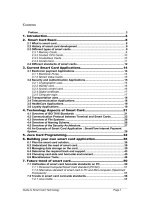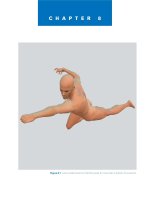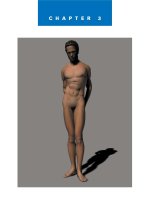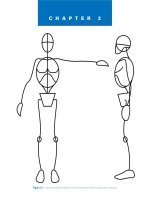Tài liệu Figure Drawing - Posing the Figure doc
Bạn đang xem bản rút gọn của tài liệu. Xem và tải ngay bản đầy đủ của tài liệu tại đây (1.14 MB, 24 trang )
CHAPTER 5
Figure 5.1 The figure’s emotion is expressed by his stance.
Posing the Figure
✎
75
T
he human figure is an expressive form. Often you can tell what people
are thinking by how they stand or hold themselves. When doing figure
drawings, you will be confronted with the choice of how to pose your
figures. This decision can be critical to the success of the drawing. Look at the
difference between the stances shown in Figure 5.1. Can you describe the emo-
tion of each figure?
The human body has an expressiveness that communicates through an unspo-
ken language often referred to as body language. As an artist, you must learn this
language and become as expressive with it as a writer is with words.
Much of the choice of how you want to pose the figures in your drawings is
determined by the purpose or goal of your drawing. It begins with the creative
germ of an idea that is developed sometimes well before a pencil is put to paper.
Sometimes the idea developed is wholly the artist’s, although many times the
artist has influence from outside sources, such as in the case of commissioned
work or commercial art.
Another important aspect of posing a character is the physical association of the
body with the environment. Because we live in a physical world, our bodies are
subjected to a number of physical forces, not the least of which is gravity. A pose
that is off balance or ignores the effects of gravity can often make for an awkward-
looking drawing. While this may not be as much of a problem when drawing
from life, it does become a problem when posing a figure in a virtual setting.
The third element to posing a figure that will be covered in this chapter is
beauty. The human form is considered by many to be the ultimate expression of
beauty. It has the potential to inspire the mind and enrich the soul, but like any
subject, it can also be seen as awkward or unsettling depending on how it is
portrayed.
76
Figure Drawing with Virtual Models
What Pose?
When faced with a white sheet of
paper that is supposed to become a
figure drawing, one of the first
questions an artist must answer is
what pose the figure should be in.
This is true whether the drawing is
a commissioned portrait or a sim-
ple figure study.
Many elements go into determin-
ing the pose for a drawing, but
they all begin with the purpose of
the drawing. Maybe the drawing is
commissioned to illustrate a story.
The artist has to visualize the story
and think of how the people in it
will interact with each other. The
characters in the story have to be
envisioned. The situations need to
be explored. The mood of the story
should also be taken into consider-
ation. For example, the story might
begin with a woman waiting for a
friend to arrive. Figure 5.2 shows a
female figure dressed in casual
clothing, with an attitude of wait-
ing for something or someone.
Using Figure Artist as a tool, the
artist has the ability to explore a
number of visual options in detail
before embarking on the task of
creating the drawing. Using Figure
Artist, you can explore creative
possibilities for posing the figures
in your drawings to help give you
the information you need to create
beautiful works of art without the
expense of hiring a model. If you
need a model for your work,
Figure Artist can help you work
out the lighting and poses prior to
your model session so there is
much less wasted time and less
chance of not getting the best pose
for your art.
One of the great advantages of a
software program such as Figure
Artist is that it has almost unlim-
ited possibilities for setting up fig-
ures as reference for your drawing.
Not only can you pose the figures
in Figure Artist in almost any posi-
tion possible for the human form,
you can also change the figures
themselves for a huge variety of
looks, from fat to thin and from
muscular to frail. A variety of cos-
tumes and facial expressions for
the virtual mannequins are also
available. But with all of this free-
dom there is also a danger because
the figure may not look natural or
like it fits into its environment.
In a real-world situation, the artist
has to follow natural laws, such as
gravity. In a virtual situation, the
artist has to remember that these
laws exist and simulate their
effects. If the artist does not plan
for the effects of gravity or perspec-
tive, then the pose can look odd or
even uncomfortable to the viewer.
For example, in Figure 5.3 the
seated figure is not in the same
perspective as the chair, making
the pose seem very out of place.
Figure 5.2 The pose is of a girl
with the attitude of waiting.
77
Posing the Figure
Balance and
Weight
For a figure to look right in its sur-
roundings, it needs to have balance
and look like it has weight. One of
the problems with posing a figure
in a virtual setting, whether it is
with a software program such as
Figure Artist or with a wooden
mannequin, is the fact that it is
easy to pose a figure that looks
slightly odd or out of place. There
could be a number of reasons for
this, but the most common one is
that the figure may not look like it
fits in the setting. The perspective
could be off. The lighting might be
wrong. More than likely, the char-
acter might not be completely bal-
anced or there might be a lack of
weight to the figure.
Balance
If the character is off balance, view-
ing it will be uncomfortable
because there will be a feeling of an
impending fall. This is not always
bad if there is a good reason for the
off-balance pose, but it is bad if it
is the artist’s oversight. In Figure
5.4 the character is leaning to one
side. He looks as if he is about to
fall. The viewer might feel the need
to try to catch him.
Being off balance is not always a
bad thing. If you are working on
an action drawing, you can use
balance as a point of action. Say,
for instance, that you are working
on a picture of a person running.
When a person runs, their weight
is shifted forward in an off-balance
position. Standing still in that posi-
tion would likely cause the runner
to topple over. The viewer recog-
nizes the off-balance position of
the person and interprets it as part
of the running motion.
Comic book artist often have their
superhuman characters in impossi-
ble poses. The exaggeration of the
Figure 5.3 Inconsistent perspective makes the scene
uncomfortable.
Figure 5.4 This guy looks like he is about to fall.
78
Figure Drawing with Virtual Models
pose can give the picture the feel-
ing of movement and superhuman
powers. Figure 5.5 shows a charac-
ter in an action pose. Not only is
the character not balanced, but he
is flying, something that a normal
human can’t do.
Because artificial environments
don’t have gravity (this includes
your drawings), you have to com-
pensate by learning how to keep
your drawings balanced. You do
this by locating the center of mass
of the body and then determining
whether it is supported by the fig-
ure. To find the center of mass,
look to the person’s hips. Even
though the chest or upper torso of
some characters might be larger
than the hip area, the hips are what
really determine the balance of a
figure. Following is an example of
how you might check the balance
on your figures.
Figure 5.5 Some poses are off balance on purpose.
79
Posing the Figure
STEP-BY-STEP
2
Draw a circle centered on the figure’s hips, as
shown in Figure 5.7. The circle locates the
center of mass for the figure.
1
The first step is to pose the figure that you
want to draw. Figure 5.6 shows a sample fig-
ure in a balanced pose.
Figure 5.6 Pose the figure.
Figure 5.7 Draw a circle around the hips.
80
Figure Drawing with Virtual Models
Figure 5.8 Draw a vertical line through the cen-
ter of the circle.
Figure 5.9 Draw the action line.
3
Now draw a vertical line that bisects the cen-
ter of the circle, as shown in Figure 5.8.
Although the line might not fall directly
between the figure’s feet, it does fall between
them. Most poses have more weight on one
foot than on the other, so the line will rarely
be in the exact center. You also need to think
three-dimensionally. In this example the char-
acter is standing at an angle to us, so that will
affect the center line as well.
4
Now draw the action line that shows the line
of motion for the figure, as shown in Figure
5.9. Compare the action line with the vertical
center of mass line. A balanced standing fig-
ure’s action line and center of mass line will
be roughly the same. The closer these two
line are, the more evenly distributed the
body weight will be between the figure’s legs.
Use these lines to check the balance of your
character.
81
Posing the Figure
This method of checking the bal-
ance of a figure is a good way to
understand whether your drawing
will look right. Let’s see how it
works for a figure that is off bal-
ance. Look at Figure 5.10. I have
drawn in the center of mass line.
Notice how it is shifted to the right.
The figure looks like he should be
sitting or leaning on something.
When the action line is drawn, you
can see that it does not match the
center of mass line very well, as
shown in Figure 5.11. The more
deviation between the action line
and the center of mass line, the
more likely the character is out of
balance.
One caution about this method is
worth mentioning: You need to
examine the figure from several
different angles. Figures exist in
3D space even though your draw-
ings will be in 2D. Often from a
specific angle, the action line will
the figure from other angles, the
lines diverge distinctly. One of the
advantages of having a virtual 3D
model to draw from is that you can
check the model from multiple
angles to make sure it is correct
before you start your drawing.
match the center of mass line. For
example, look at the three views of
the figure in Figure 5.12.
The figure is definitely not bal-
anced, yet in the first view on the
left, the lines correspond well to
each other. However, if you look at
Figure 5.10 The center of mass
line is shifted to the right.
Figure 5.11 The action line deviates
far from the center of mass line.
Figure 5.12 Make sure to check the figure for balance from several angles.
82
Figure Drawing with Virtual Models
Hip and Shoulder
Relationship
One of the most interesting aspects
of the human body is the spine.
The spine is a flexible segmented
series of bones that runs from the
pelvis to the skull. The spine con-
nects our upper body with our
lower body. One of the advantages
of flexibility in the spine is that it
helps us to keep our balance while
standing or walking. For example,
when a person walks, the hips will
tilt from side to side. If the spine
were not flexible, the tilting of
the pelvis would throw the body
off-balance. Because the spine is
flexible, it bends and shifts the
weight of the upper torso to com-
pensate and counterbalance the
tilting of the pelvis.
Usually the hips and pelvis move
in opposite directions to try to
keep the body in balance. In art,
this opposing movement is called
contrapposto and often an artist will
accentuate the shift because it cre-
ates a more interesting pose.
Figure Artist has a feature called
the Hip-Shoulder Relationship
Guide that helps the artist to see
the relationship of the hips to the
shoulders. The shoulders are repre-
sented by a blue rectangle and the
hips are represented by a yellow
rectangle. When this feature is
turned on, it is easy to see the posi-
tion of the hips in relation to the
shoulders. The guide is pictured in
Figure 5.13.
In this example, the skeleton is in
the act of walking. Notice how the
right hip is up while the right
shoulder is down. Figure 5.14
shows the curvature of the spine.
Figure 5.13 The Hip-Shoulder Relationship Guide
helps to show the shift of the hips and shoulders.
Figure 5.14 The spine twists and turns as a person
walks.









